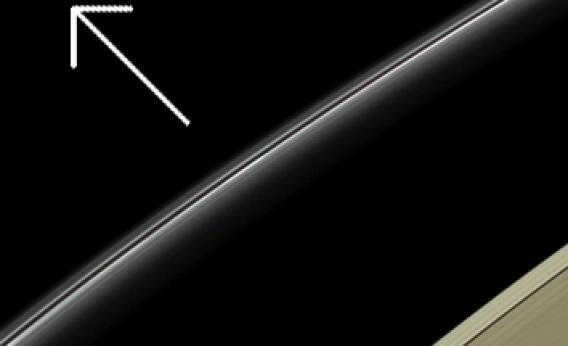Create a free profile to get unlimited access to exclusive videos, sweepstakes, and more!
Cassini Spies Another Pale Blue Dot

Speaking of Saturn’s rings, on April 11, 2014, Cassini was taking a snapshot of Saturn’s thin outer F ring when it got a bonus: Uranus!
The picture above shows the seventh planet from the Sun as a small, pale blue dot (hmmmm, that sounds familiar). Uranus is actually a big planet, four times wider than Earth, but it was a staggering 4.3 billion kilometers (2.7 billion miles) from Saturn when this shot was taken, nearly on the opposite side of the Sun. It’s amazing Cassini saw anything at all (though, to be honest, in the image Uranus was brightened by a factor of 4.5 to make it more obvious, and the A ring—the broad ring at the lower right—was also brightened for clarity). Uranus was just barely more than a dot, even to Cassini’s narrow-angle camera.
Uranus is generally visible from Earth using binoculars; it’s just on the edge of naked-eye visibility. Right now it’s an early-morning object near Venus in the predawn sky. Seeing it through even a small telescope is a bit shocking; it’s clearly a disk, not a point-like dot like a star, and a very distinctive blue-green. The upper atmosphere of the planet has a lot of methane which is excellent at absorbing red light. Sunlight that hits Uranus gets its red removed, leaving the blues and greens to reflect off and travel their way back to us.
With bigger telescopes, Uranus has another surprise: rings! You can’t see them in the Cassini shot—they’re far too faint—but they’re there. So we’re looking through the rings of one planet to spy on another that has rings as well. The solar system is a weird place.
Another funny thing that struck me in this image is how well-behaved the F ring looks! Usually it’s a mess, but it depends on what part you’re looking at. The moons Prometheus and Pandora can stir things up, for example, and sometimes an impact with a meteoroid can create havoc as well. It’s actually rather odd to see the F ring so well-groomed here (although, if you look carefully, you can see some twists and changes in it as your eye seeps around it).
It’s fun to see images like this, analyze them, and see what surprises lie therein. You might see an entirely other world … or you might have to just be satisfied with seeing the splendiferous glory of Saturn’s rings dancing to the tune of Newtonian gravity. I’ll take it.


























